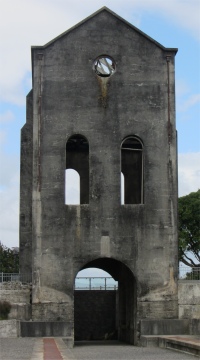 Cornish Pumphouse |
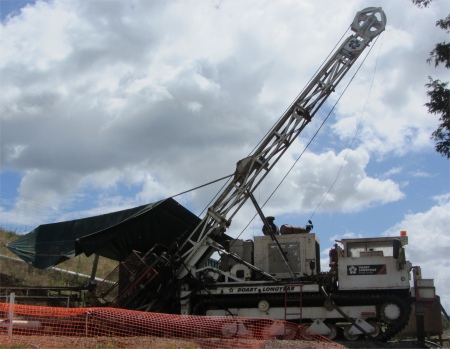 Drilling Platform for Rock Samples |
The town grew up on top of a gold mine, whose history dates back to 1878. It was February of 1878, when prospectors Robert Lee and John McCombie found glistening quartz, and then gold on Pukewa (Martha Hill). The pair worked tirelessly for months before having two tonnes treated at the Smile of Fortune Battery at Owharoa. The return was one pound and eleven shillings per tonne. They finally abandoned their claim and headed off in search of better fortunes.
Eventually, William Nicholl staked a claim on Pukewa spur near McCombie and Lee's workings in 1879. He named it Martha after his favourite niece.
By the early 1880s prospectors dotted Waihi, mining for gold using only picks and shovels. They used picks to break out ore samples from Martha Hill, crushing the ore using hammers. To find the reefs, tunnels were cut into the hill by hand, a task that could take months.
The deepest vertical shaft plunged 600m from the surface. Radiating from the seven vertical shafts, a 175km long network of tunnels was opened on 15 horizontal levels. About 600 men usually worked the mine but in 1909, when gold production peaked, 1500 people worked between the mine and its stamper battery at Waikino.
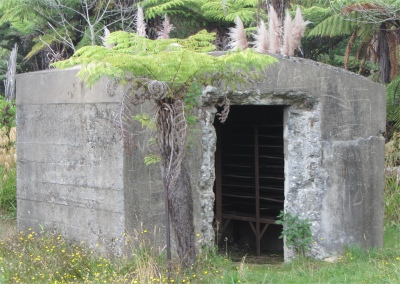 Grand Junction Battery Bullion Store |
Housing in early Waihi was in most cases quite primitive. Most houses were a basic box shape of one or two rooms, built of wood with a corrugated iron roof. They were temporary structures, as mining was considered temporary.
To get a house, miners sometimes resorted to desperate measures. Accidents in the mine were common and compensation was paid to miners who lost limbs.
This gave rise to the practice of cutting off digits in order to receive the compensation. It was often said that you could get a house for a thumb. Preserved examples of severed thumbs are on display in the Waihi Museum.
To prevent the pilfering of candles from the mine, the company had all the candles coloured pink. Guess what, most houses in Waihi were lit by pink candles.
Pensioners and those disabled from the mine used to sit at the sides of the roads with knapping hammers, earning a little money from their Borough by breaking big rocks into small ones for use on the roads. Children used to beg for pretty rocks and often went away with amethyst and other forms of attractive quartz.
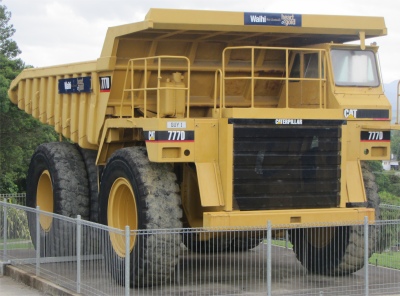 Giant 777D Caterpillar Truck |
In order to transport ore around the area from mine to battery, the town was crossed with a number of small railway lines along which ran small trains. The best known and longest-lived of these was known as "the rake".
This narrow gauged train took the ore from the Martha Mine to Victoria Battery until the mine closed in 1952. The rake consisted of a small steam engine which pulled a line of numerous small trucks loaded with ore. Its shrill whistle had a habit of making horses bolt.
The extracted gold was returned to Waihi for refining then transported out of town on an open wagon with a driver and a guard. Children were in awe of this vehicle because the guard carried a gun.
After the underground mine closed in 1952, until the prospecting started that led to the present open cut mine, Martha Hill was a wilderness of pines, wattles, fern and weeds.
Despite many signs warning of the dangers of shafts, local youngsters frequently used the hill as a retreat from parental supervision.
A notorious prison escaper used it as a hideout for a time. He was eventually apprehended after robbing a Waihi bank and leaving a trail of coins from the bank, up Haszard Street, to Martha Hill. It is said that at one stage he joined in his own search party.
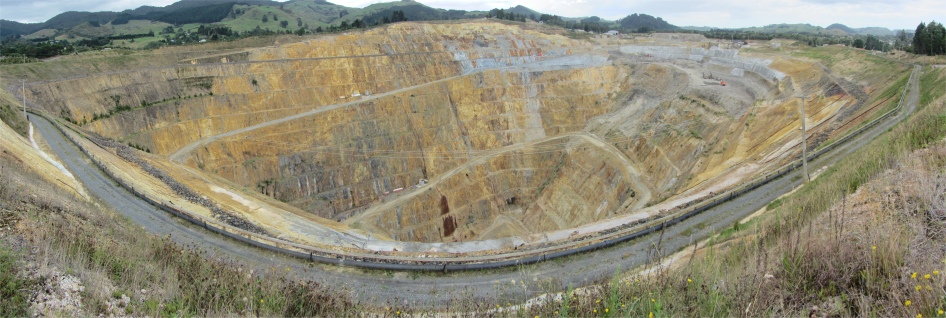 Martha Mine |
I decided to tackle the Pit Rim Walkway, a 4km hike around the periphery of the open cast mine. and is slap bang right by the town centre. Where Martha Hill once stood, a large gaping hole in the ground existed.
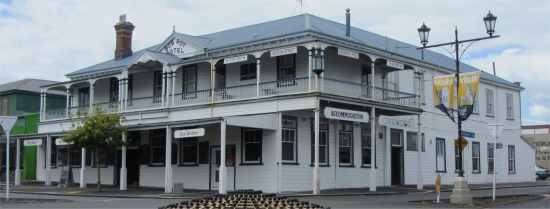 Rob Roy Hotel |
One historical building which did fascinate me was the Cornish Pumphouse, built in 1903 to house steam engines and pumping equipment to dewater the historic underground Martha Mine.
The horizontal pump had a stroke of 4m. Steam machinery powered the pump to continuously dewater underground workings via the adjacent Number 5 Shaft. It pumped out 7,000 litres of water per minute. The shaft was 399 metres deep.
The pumphouse was retired from use in 1913 when its steam power was replaced by electricity. In the early 30s it was stripped of machinery and left derelict.
Deep-seated land movement in old mine workings beneath the pumphouse had the potential to threaten the stability of the structure. Around 1960 the collar of Number 5 Shaft collapsed, leaving the pumphouse on the edge of a potentially dangerous void. By the beginning of 2005, experts advised, "Move it - or lose it."
When the current mining licence was granted in 1987, a condition stated that the mining company must take all necessary precautions to protect the historic building.
The 298m move began in August 2006. The building rested on teflon pads, which slid along a stainless steel plate on concrete beams, pushed and pulled by hydraulic rams. After a day, the move was complete, and the Cornish Pumphouse now makes a unique backdrop for a variety of events.
 Waihi Sculptures |
Returning back to town, I walked the length of Seddon Street, which had a series of interpretive signs describing the town's history, and a series of relevant sculptures, reflecting the mining history, the harsh conditions, and a young lad with his feet in the gutter. Apparently waste water from the mine, which was warm, used to run down the gutters, and kids used to bathe their feet in it.
Sadly, rain appeared, so I left this fascinating area and started to head up to the Coromandel Peninsula. The road weaved its way through rich agricultural land with swathes of Pick-Your-Own farms, before encountering hills. It then became a series of twists and turns inducing the same feeling as being on a yacht in the North Sea in a Force 7. Pots, pans and everything in the back of the wagon created their own syncopated rhythm as I traversed these hills and mountains.
I was now heading up along the Coromandel Peninsula, a part of the Waikato Region and Thames-Coromandel District extending 85 kilometres north from the western end of the Bay of Plenty, forming a natural barrier to protect the Hauraki Gulf and the Firth of Thames in the west from the Pacific Ocean to the east. At its broadest point, it is 40 kilometres wide. The peninsula is steep and hilly, and is largely covered in subtropical rain forest. A forest park covers much of the peninsula's interior. A huge history is associated with this particular region due to the ancient Kauri forests that used to cover the entire area. In the late 18th and early 19th century this area was logged to within an inch of its life by the Europeans who felled huge tracks of Kauri forest. The Coromandel Range forms a spine for the peninsula rising to nearly 900 metres. Its rugged nature means that much of it is relatively isolated, and the interior and northern tip are both largely undeveloped and sparsely inhabited. Almost the entire population lies on the narrow strips along the Hauraki Gulf and Bay of Plenty coasts. The peninsula is a popular place to live for those who have chosen an alternative lifestyle, especially for those who have elected not to live in Auckland. The 1970s saw thousands of hippies relocate from large cities around New Zealand to the Coromandel in search of an environmentally friendly lifestyle associated with the counterculture back-to-the-land movement. In recent times, increasing numbers of affluent Aucklanders are also moving to the Coromandel.
The peninsula was named after HMS Coromandel, an early sailing vessel that transported kauri spars destined for the Royal Navy. A few remnant kauri forests remain in the hinterland.
But soon I found myself dropping down to the small holiday town of Whangamata, nestled on the mouth of the large picturesque Whangamata Harbour. This appeared to be a fishing haven with dozens casting off from the crowded pier, and others in the more spacious surroundings of the beach. Numerous small charter fishing boats were returning, trying to beat the ebbing tide by the looks of it. This was a truly water based resort, which apparently soars to a capacity of 40,000 during the New Year period, mainly young folk and the surfing fraternity. During winter the main sport is tumbleweed spotting. I took time out and strolled along the beach for a while. Trots of yachts were moored up inside the large harbour, and island sanctuaries stood out like green gems out in the bay; all very much picture postcard material.

